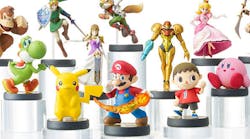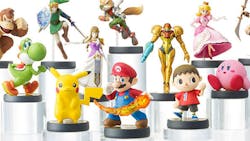NFC Applications Venture into New Territories
For several years now, analysts, journalists, and tech enthusiasts alike have been predicting the boom of near-field communication (NFC). This short-range communication technology, which has been integrated into Blackberry, Google, Motorola, Nokia, and Samsung smartphones, finally made its way into Apple’s iPhone 6 and Apple Watch. As NFC becomes standard in a growing number of connected devices, we’re seeing more innovative uses for the technology, from practical business applications, to inspiring humanitarian functions, to video games and beyond.
Aside from the more common uses of NFC (including mobile payments, ticket-less travel, etc.), developers are coming up with quite unique and interesting applications for the contactless technology. Information sharing has already become incredibly fast, but now with NFC, it’s become truly easy, as users can simply tap two phones together to exchange contact or other information.
This file type includes high resolution graphics and schematics when applicable.
Similarly, NFC-enabled “business tags” are becoming alternatives to conventional business cards. They allow the recipient to automatically save and store contact information to their device, bring up a website, or send an email on the spot. For business people, this means a more efficient form of organization and communication as well as less wasted paper.
In addition to being helpful in a day-to-day sense, NFC technology is being used to create some real positive change in the world. Tech-savvy organizations are beginning to utilize NFC in inventive new ways to raise money and develop new organizational systems.
In 2014, the UN World Food Programme ran a week-long campaign in Halle, Germany that enabled citizens to make a charitable donation via NFC. Users could tap their phones against an NFC-tagged poster at a local bus shelter and donate money for food. This “tap to give” method is particularly attractive to charitable organizations and nonprofits—it doesn’t require a patron to download a separate app or log onto a complicated website, thus significantly reducing the effort required and increasing the likelihood of donations being made.
In another example, the International Fertilizer Development Center (IFDC) launched an NFC-based pilot program called GES (Growth Enhancement Support) Touch and Pay (TAP) that allows Nigerian farmers to redeem subsidized farming products—including seed and fertilizer—by simply tapping an NFC card against a tablet at designated redemption spots across the country. At least 470,000 farmers have entered the program as of July 1. The goal is to extend this system to health centers and transportation within Nigeria.
On the healthcare front, Gentag developed what it calls NFC Skin Patches, similar to ordinary Band-Aids. When combined with their unique biosensor integrated circuits, these NFC Skin Patches enable a variety of health- and fitness-related applications. These include monitoring of a patient’s temperature; tracking of an athlete’s heart rate, temperature, hydration, sweat, blood sugar, lactic acid, electrolytes and other biomarkers; monitoring of environmental conditions such as UV exposure; measurement of glucose levels; and even precise delivery of medication. Such low-energy solutions can actually be powered by the energy transferred through an NFC-coupled link.
Let’s not forget that NFC can be used for a number of unique, fun applications as well. Disney Infinity and Skylanders—and now Nintendo—introduced NFC-equipped figurines that can be synched with video games for a more interactive experience. Called amiibo characters, this is a particularly simple integration for Nintendo, since Wii U’s GamePad controller has an NFC reader already built into it.
Nintendo explains that by tapping the amiibo figurines against the GamePad, users will be able to insert their characters into a variety of Nintendo games, starting with Super Smash Mario Brothers this holiday season. Because NFC is a two-way communication system, the figurines are able to store data such as customizable skills, special moves, and character stats. Depending on the success of amiibo, the video-game world could be seeing many more NFC-compatible games in the near future.
Whether used to create a high-tech scavenger hunt or automate your home, the unique possibilities for NFC are seemingly endless. With the growing applications for this new technology, it’s going to be especially important for mobile-device manufacturers to thoroughly test their products to ensure these NFC features work to their full capacity. Nothing could be more detrimental to an emerging technology than constant complaints of unreliability and failure to perform properly. To prevent high rates of return, or products dumped in the trash, manufacturers need to commit resources to testing these connected devices.
This file type includes high resolution graphics and schematics when applicable.
Curtis Schmidek, vice president of marketing, is responsible for defining LitePoint's wireless production test solutions. Curt has over 25 years of experience in wireless product development and marketing, ranging from semiconductors, intellectual property development, and ODM services. He received his BSEE from the University of California at Davis and his Master’s degree in business administration from Santa Clara University.



